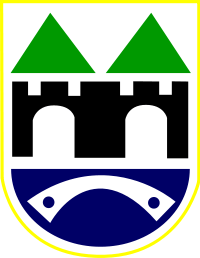Sarajevo Synagogue
| Sarajevo Synagogue | |
|---|---|
 | |
| Basic information | |
| Location |
|
| Affiliation | Orthodox Judaism |
| Rite | Ashkenaz |
| Status | Active |
| Architectural description | |
| Architect(s) | Karel Pařík |
| Architectural style | Neo-Moorish |
| Completed | 1902 |
Sarajevo Synagogue (Bosnian, Croatian and Serbian: Sinagoga u Sarajevu / Синагога у Сарајеву) is Sarajevo's primary and largest synagogue and is located on the south bank of the river Miljacka. It was constructed in 1902 and remains the only functioning synagogue in Sarajevo today.

History
A Sephardi synagogue (also known as Sijavuš-pašina daira or Velika Avlija) is known to have been built in 1581 with the donation of Turskish beglerbeg Sijamuš-paša to help members of the Jewish community in Sarajevo who were poor. By the end of the 16th century, the space encompassing Velika Avlija was turned into the first synagogue. The building burned down in both 1679 and 1778, and was rebuilt each time. It now serves as a Jewish museum. Next door is the New Synagogue (Novi Hram) serving as an art gallery owned by the Jewish community of Sarajevo. The magnificent Sephardic synagogue of 1932 (Il Kal Grande) acknowledged as the largest and most ornate synagogues in the Balkans, was destroyed by the Nazis in 1941.[1]
Ashkenazi Jews arrived in Sarajevo with the Austro-Hungarian Empire in the late 19th century. An Ashkenazi synagogue, seen in the photo to the right, was built in 1902 in an elaborate Moorish Revival style. Designed by Karel Pařík, its highly decorated neo-Moorish style was a popular choice for synagogues in the Austro-Hungarian Empire.
The synagogue has enormous arches with richly-painted decorations. The high, ornate ceiling was highlighted by a ten-pointed star. Today the synagogue is confined to the women's galleries on the upper floor. At the entrance, a stone menorah commemorates the 400-year anniversary of the Jews in Bosnia and Herzegovina.
The devastation wreaked by the Holocaust and the civil war during the 1990s has left fewer than 5,700 Jews in the former Yugoslavia. The Jewish community, like the entire country, was once defined by its unique combination of eastern and western traditions. Populations of Sephardi and Ashkenazi Jews peacefully co-existed with their Christian and Muslim neighbors in Sarajevo and elsewhere in Bosnia and Herzegovina.
See also
References
Sources
| Wikimedia Commons has media related to Sarajevo Synagogue. |
Coordinates: 43°51′23″N 18°25′30″E / 43.85639°N 18.42500°E
